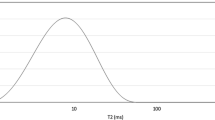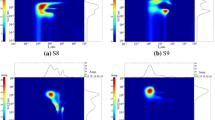Abstract
A new criterium is proposed as a hypothesis that gives a dividing line between conventional and unconventional reservoir rocks from the permeability point of view. For rocks with higher permeability, the laboratory porosity values are higher than the NMR porosities. For rocks of lower permeability, the laboratory porosity values are lower compared to NMR porosities. This tendency of permeability to control the relation between porosities measured by two techniques is noticed in published data collected from different literature sources.
Similar content being viewed by others
Avoid common mistakes on your manuscript.
Introduction
NMR and laboratory porosity measurements were collected from published papers for carbonate rock plugs. Three sets of data were used in this study, two of which are from the same source: (1) Twenty-seven (27) carbonate core plugs analyzed by low-field NMR and conventional core analysis (Chang et al. 1997), (2) a total of 35 core plugs selected from off-shore, carbonate, oil-producing formations (the Glorieta carbonates in West Texas): Field A. (Lyne et al. 1996), and (3) a total of 29 core plugs selected from off-shore, carbonate, oil-producing formations (the Clearfork carbonates in West Texas): Field N. (Lyne et al. 1996).
Porosity and permeability procedures
Porosity can be determined by different lab procedures. Porosity is determined by using helium-gas expansion as described by Boyle’s law (Kazimierz et al, 2004) where in a gaseous system at a given temperature, the product of absolute pressure and volume is constant. Also, porosity is calculated by using saturation method where the pore volume is determined by dividing the difference in weight between the saturated sample and the dry sample by the known density of the saturating fluid.
And by applying Archie’s laws on laboratory-measured electrical properties (i.e., resistivity, formation resistivity factor, and cementation exponent), porosity is calculated (Efnik et al, 2006). In NMR measurements, core plug measurements provide important details about the variations in the pore size, and free/bound fluid volumes (Moss, 2004).
Using Darcy’s law, permeability is calculated from fluid flow rate, cross-sectional area of the core sample, differential pressure (between upstream and downstream pressures), viscosity of flowing fluid, and length of the core sample.
For the first set (Chang et al, 1997), plugs were cleaned for laboratory porosity measurements by hydrostatic weighing in toluene and for Klinkenberg-corrected air permeability measurements. Then, the samples were saturated by brine for NMR porosity measurements. Similarly, the second set of plugs (Lyne et al, 1996) were cleaned and resaturated with brine. Laboratory (conventional) porosity and permeability measurements were conducted by following the Archimedes principle and the Klinkenberg correction, respectively (Tanikawa and Shimamoto, 2006). The NMR porosity values were calculated directly from the NMR signals as they are proportional to the volume of fluids in the pore systems.
Interpretation
Inverse relations between the relative errors of porosities and permeability values are shown in Figs. 1, 2, and 3. When NMR porosity is greater than conventional plug porosity, the permeability value is expected to be low and vice versa.
Tendency of permeability control on porosities’ relationship for 75 % of the data: Permeability versus relative error between NMR and Lab porosities (Data taken from Chang et al. 1997)
Tendency of permeability control on porosities’ relationship for 74 % of the data for Field A: Permeability versus relative error between NMR and Lab porosities (Data taken from Lyne et al. 1996). Note that this group can be divided into two sets (red squares with higher permeability values and blue diamonds with lower permeability values) having the same relationship
Hypothesis
The measured permeability values were plotted against the relative error between “NMR” porosity and “LAB” porosity (Figs. 1–3).
The permeability controls the relation between NMR-measured porosity and conventional laboratory-measured porosity according to the best fit relationship:
where y is the permeability and x is the relative error of porosity measurements.
I assume, as a work hypothesis, that for higher permeability values, the laboratory porosity values are higher than the NMR porosities (Fig. 4). And, for lower values of permeability, the laboratory porosity values are lower compared to NMR porosities. It seems likely that this observation would establish a discriminatory threshold between conventional and tight rocks. Further research is needed to involve in this study the three classic log-derived (density, neutron, and sonic) porosities and their relation with the NMR porosity.
Conclusion
The proposed trend—if verified—could delineate the boundary between conventional and unconventional rocks from the permeability point of view. However, more data are needed for a better definition of the control parameters.
References
Chang D, Vinega H, Morriss C, Straley C (1997) Effective porosity, producible fluid, and permeability in carbonates from NMR Logging. The Log Analyst, March.-April, 60–72
Efnik M, Dernaika M, Kalam M (2006) Evaluation of Water Saturation from Laboratory to Logs. The International Symposium of the Society of Core Analysts. SCA2006-56 p 1–6
Kazimierz T, Jacek T, Stanisław R (2004) Evaluation of Rock Porosity Measurement Accuracy with a Helium Porosimeter. Acta Montan Slovaca 9(3), p 316–318
Lyne A, Vaflni G, Ghilardotti G (1996) Determination of petrophysical properties of carbonate rocks by NMR relaxometry. Society of Petroleum Engineers, (SPE 36852), 331–339
Moss A (2004) NMR Core Plug Measurements to Compliment SCAL studies. The International Symposium of the Society of Core Analysts. SCA2004-47 p 1–6
Tanikawa W, Shimamoto T (2006) Klinkenberg effect for gas permeability and its comparison to water permeability for porous sedimentary rocks. Hydrol Earth Syst Sci Discuss 3, 1315–1338
Acknowledgments
The author thanks Professor Gabor Korvin (King Fahd University of Petroleum and Minerals, KFUPM, Saudi Arabia) for his valuable comments and suggestions which improved the original manuscript.
Author information
Authors and Affiliations
Corresponding author
Rights and permissions
Open Access This article is distributed under the terms of the Creative Commons Attribution 4.0 International License (http://creativecommons.org/licenses/by/4.0/), which permits unrestricted use, distribution, and reproduction in any medium, provided you give appropriate credit to the original author(s) and the source, provide a link to the Creative Commons license, and indicate if changes were made.
About this article
Cite this article
Aqel, M.A. RESEARCH NOTE: permeability control on the relationship between nuclear magnetic resonance (NMR) measured porosity and routine core porosity. Arab J Geosci 9, 350 (2016). https://doi.org/10.1007/s12517-016-2335-8
Received:
Accepted:
Published:
DOI: https://doi.org/10.1007/s12517-016-2335-8








